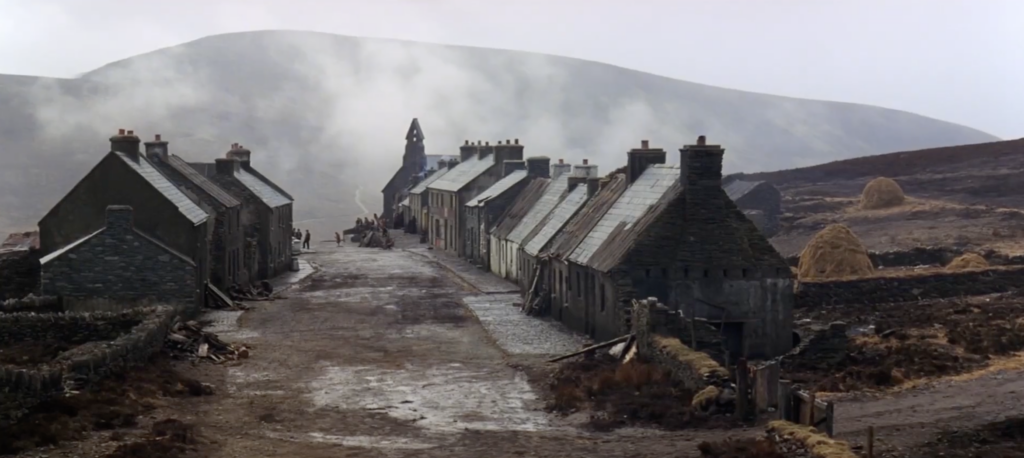Ryan's Daughter Village
Ceathrú an Fheirtéaraigh
|
Ferriters-quarter
Address
Ceathrú an Fheirtéaraigh, Dún Chaoin, Corca Dhuibhne
52.147868
, -10.445675

The fictional village of Kirrary was constructed at this dramatic location at the foot of Cruach Mhárthain, above Dún Chaoin. For months ahead of shooting, local people were employed alongside professional setbuilders to construct the exterior structures. Fitzgeralds, the local builders’ providers supplied much of the construction material. Overall, it was seen as a good source of employment at the time, and many from the area recount how the film generated a lot of wealth locally, stimulating the local economy, and spurring on the burgeoning hospitality industry. When production was complete, consideration was given to leaving the set in place, to serve as a tourist attraction. Ultimately this was decided against, and all that remains today are the cobblestones that formed the main road through the village.
Without a doubt, Ryan’s Daughter put the Dingle Peninsula on the modern map – literally, figuratively, and in all-ways speaking. West Kerry’s history as a destination for early Christian ascetics, Spanish merchants, and even early sound era filmmakers (see: West of Kerry) notwithstanding, Dingle and its surrounds were an economic backwater (if not wasteland) in the middle of the twentieth century. Then came Ryan’s Daughter.
The best resource on Ryan’s Daughter (and some very fine storytelling) comes from local historian Micheál De Mordha in his Irish-language book An Rialtas Ab Fhearr! (The Best Government Ever!) In it, he tells the full story of how internationally acclaimed English director David Lean (Lawrence of Arabia and Doctor Zhivago) brought his epic vision (adapted from Madame Bovary) – along with stars Robert Mitchum, Vera Miles, Trevor Howard and John Mills (who won an Oscar for his portrayal of the intellectually impaired Michael) – along for its (over)shoot, ultimately jump-starting West Kerry economically and cementing its status as a tourist destination. Cinephile pilgrims still flock to the one still-standing structure of the set, the “Ryan’s Daughter schoolhouse”, which was specially built for the film and the only building allowed remain by the production company (following local squabbling over private ownership).
Today the schoolhouse’s roof has fallen in, and it is little more than a boxed shell. Yet it stands starkly against the Dunquin coastline, partially viewable from the Slea Head Drive and accessible on foot from the Ionad an Bhlascaoid. It is just a couple of yards from the ancient holy well, Tobar Ghobnait, which is dedicated to St Gobnait, the patron saint of Dunquin. This site, too, receives its own pilgrims and worshippers today. Like so many locations in West Kerry, the ancient abuts the modern here, religion mixing with secularism, commercialism with art.
This is some of what makes Ryan’s Daughter so rich: a film about ideological conflict (loyalism versus Republicanism; fidelity versus passion) is itself so complex and conflicted in terms of its production history, its juggling of geographical locations (West Kerry in one shot is represented by a strand in South Africa in the next), its propulsion of loosening censorship practices in Ireland and the MPAA system (thanks to its nude scenes), and the “value” ascribed to it by film critics versus business analysts.
Inarguably, Ryan’s Daughter is aesthetically beautiful to look at, with cinematogapher Freddie earning an Oscar for its 1970 release. It remains for the viewer to decide whether the narrative substance behind its aesthetic veneer is separable or not, factorable in, and/or discountable towards in any individual assessment of the film’s overall “quality”. Perhaps it may come down to whether the film affects the individual audio-viewer emotionally, and in what way, through narrative and/or purely aesthetic appreciation. Regardless, this film was and always will be fundamental to understanding West Kerry economics and culture today.

